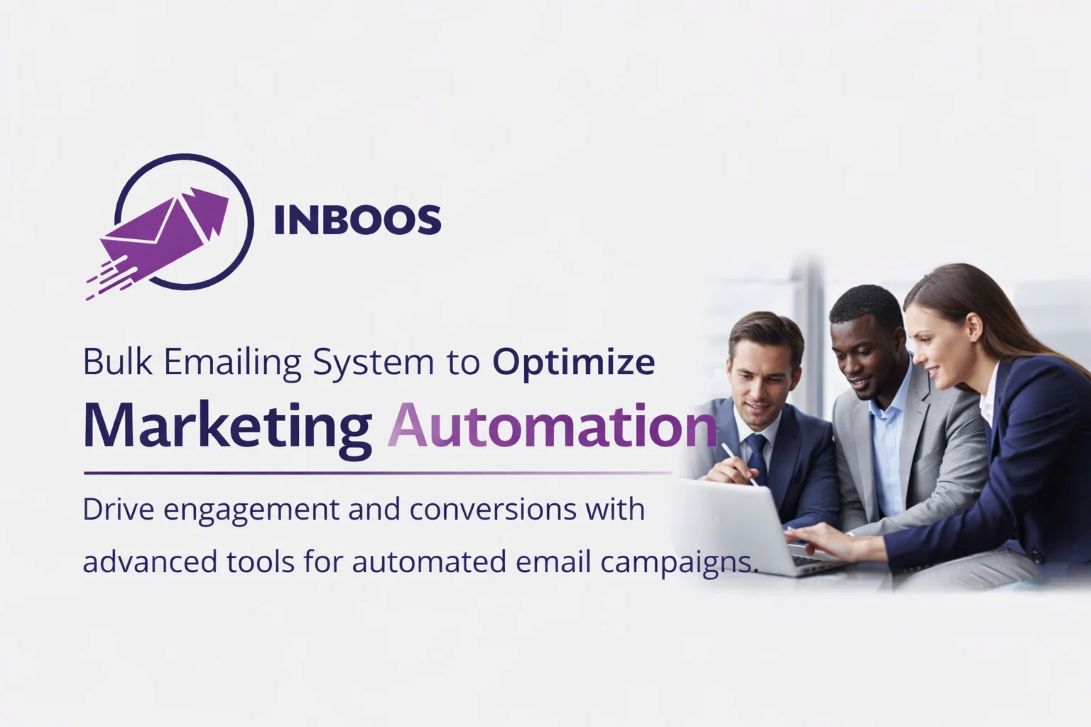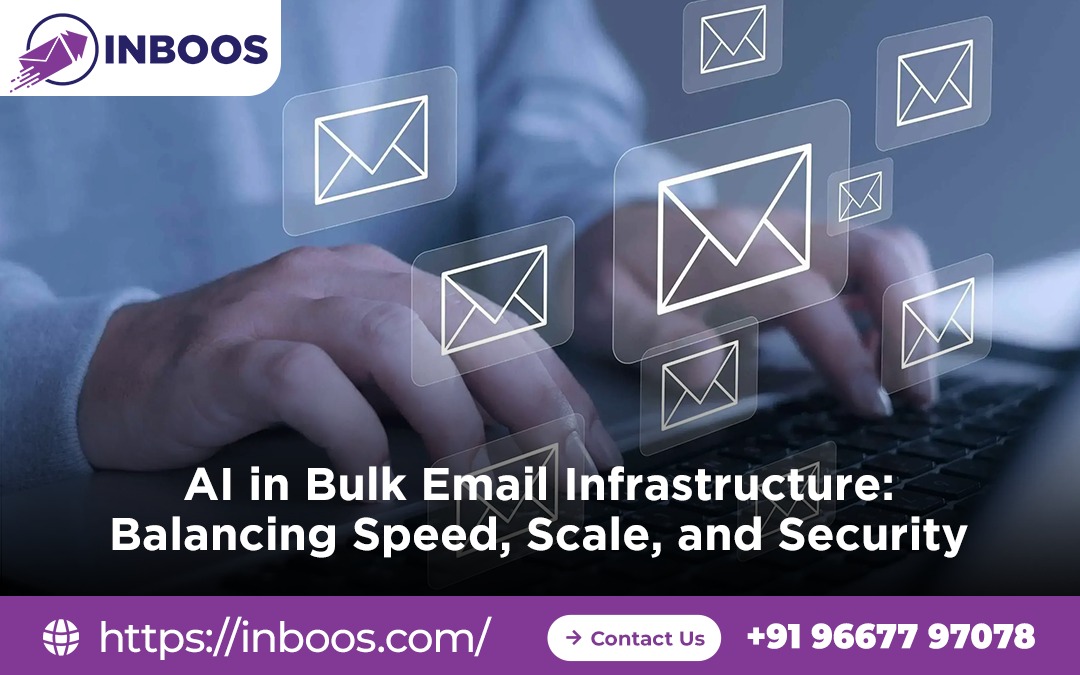Bulk email infrastructure is the engine behind high-volume email campaigns. Whether you’re sending onboarding emails, transactional updates, or promotional newsletters, your infrastructure determines how fast, secure, and scalable your delivery is. But as email volumes grow, so do the challenges—slow delivery, spam filtering, server overload, and security risks.
Table of Contents
ToggleThis is where artificial intelligence (AI) steps in. AI can optimize bulk email systems to deliver faster, scale smarter, and protect better. In this guide, we’ll explore how AI transforms bulk email infrastructure, the key challenges it solves, and how to implement it step by step.
What Is Bulk Email Infrastructure?
Bulk email infrastructure refers to the technical setup that allows businesses to send thousands—or millions—of emails reliably. It includes:
- SMTP servers
- IP pools
- Email queues
- Authentication protocols (SPF, DKIM, DMARC)
- Delivery monitoring systems
Without a strong infrastructure, even the best email content won’t reach your audience.
Key Challenges in Bulk Email Delivery
| Challenge | Description |
|---|---|
| Speed | Delays due to server throttling, queue congestion, or ISP rate limits |
| Scale | Difficulty managing large volumes without delivery failures |
| Security | Risks of spoofing, phishing, and spam flagging |
| Reputation | Poor sender scores due to bounce rates or spam complaints |
| Monitoring | Limited visibility into delivery performance and ISP behavior |
How AI Solves These Challenges
Artificial intelligence can analyze patterns, predict issues, and automate decisions across your email infrastructure. Here’s how AI improves each area:
1. Speed Optimization
AI monitors delivery queues and ISP response times in real time. It can:
- Prioritize high-value emails
- Adjust send rates based on ISP feedback
- Detect bottlenecks and reroute traffic
This ensures faster delivery without overwhelming servers.
2. Scalable Sending
AI dynamically allocates IP addresses and server resources based on volume and engagement. It can:
- Auto-scale infrastructure during peak campaigns
- Segment audiences for staggered delivery
- Balance load across multiple SMTP endpoints
This prevents overload and improves inbox placement.
3. Enhanced Security
AI strengthens email security by:
- Detecting spoofing attempts and unauthorized access
- Enforcing SPF, DKIM, and DMARC policies
- Monitoring for phishing patterns and malicious links
It also adapts to new threats faster than manual systems.
4. Reputation Management
AI tracks bounce rates, spam complaints, and engagement metrics. It can:
- Suppress risky addresses
- Adjust content based on spam filter behavior
- Rotate IPs to protect sender reputation
This helps maintain high deliverability over time.
AI vs Traditional Bulk Email Systems
| Feature | Traditional System | AI-Optimized Infrastructure |
|---|---|---|
| Send Rate Control | Manual throttling | Real-time adaptive throttling |
| IP Management | Static allocation | Dynamic IP rotation |
| Bounce Handling | Reactive | Predictive suppression |
| Spam Filter Response | Limited | Behavioral analysis |
| Infrastructure Scaling | Manual provisioning | Auto-scaling based on demand |
| Security Monitoring | Rule-based | Threat detection via ML models |
Step-by-Step Guide to Implementing AI in Bulk Email Infrastructure
Step 1: Audit Your Current Setup
- Identify SMTP servers, IP pools, and authentication protocols
- Review bounce logs, spam complaints, and delivery times
- Map out your sending volumes and peak periods
Step 2: Choose an AI-Enabled Email Platform
Look for platforms that offer:
- Real-time delivery analytics
- AI-based IP rotation and queue management
- Built-in security monitoring
- Integration with your CRM or marketing stack
Examples include SendGrid, Mailgun, Postmark, and custom AI layers built on top of SMTP.
Step 3: Configure Smart Sending Rules
- Set thresholds for engagement-based throttling
- Enable auto-suppression of inactive or risky addresses
- Use AI to segment audiences based on behavior
Step 4: Monitor and Adapt
- Track delivery performance across ISPs
- Use AI insights to adjust subject lines, content, and timing
- Continuously test and refine your infrastructure
Step 5: Secure Your Infrastructure
- Enforce SPF, DKIM, and DMARC
- Use AI to detect anomalies in sending patterns
- Monitor for unauthorized access or spoofing attempts
Best Practices for AI-Driven Bulk Email Delivery
- Use dedicated IPs for transactional vs promotional emails
- Monitor engagement metrics and adjust send frequency
- Avoid sending to unverified or outdated email lists
- Test email content against spam filters before sending
- Keep authentication protocols up to date
- Use AI to personalize delivery timing based on user behavior
World Impact of AI in Email Infrastructure
| Metric | Before AI Optimization | After AI Integration |
|---|---|---|
| Average Delivery Time | 12 minutes | 3 minutes |
| Bounce Rate | 8.2% | 2.9% |
| Spam Complaint Rate | 1.5% | 0.4% |
| Inbox Placement Rate | 84% | 96% |
| Server Downtime | 3 hours/month | <30 minutes/month |
AI is no longer optional in bulk email infrastructure. As email volumes grow and security threats evolve, AI provides the intelligence, adaptability, and automation needed to deliver emails faster, safer, and at scale.
By integrating AI into your email systems, you can optimize performance, protect your reputation, and ensure your messages reach the inbox—every time.
If you’d like, I can also generate microblog ads, landing page copy, or internal linking strategies to support this post across Inboos.com. . Just say the word.
📩 Have Questions or Need Expert Help?
Our team is here to make your email marketing, bulk emailing, and mass emailing effortless and effective.
🚀 Let’s boost your deliverability, scale your outreach, and unlock better results!
👉 📌 Contact Us Today
 logo
logo




